
Official Edgar Rice Burroughs Tribute and Weekly Webzine Site
Since 1996 ~ Over 10,000 Web Pages in Archive
Presents
Volume 1335
Tales of Space and Time #1
In Quest of the Origin of Tarzan
by R. E. Prindle

Tales of Space and Time #1
In Quest of the Origin of Tarzan
by R. E. Prindle
The goal of my quest here is not the literary or external sources of Tarzan but the internal and psychological necessity that forced the idea of Tarzan from Burroughs' mind. I will divide my inquiry into two parts, the first being the creation of Burroughs' fixation and the traumas to ERB's Anima and Animus which led to Tarzan, the second part dealing with ERB's resolution of his fixation and traumas which ended in the creation of Tarzan.I will analyze ERB's psychotic reaction to his Challenge using the Prindle Modification of the Freudian System.
The Fixation And Traumas
There must be some way outta here,
Said the Joker to the Thief.
Bob Dylan - All Along The Watch Tower
The problem has been to isolate ERB's central childhood fixation in his writings so that it can be analyzed. I had noted the extraordinary use of the name John in ERB's novels. Some Johns were good; some Johns were evil. Sometimes a good John fought a bad John. Four generations of Claytons are named John. It would seem that the fixation had something to do with someone named John.I read somewhere that at one time ERB thought of changing his name to John which was even more puzzling. Then Ye Editor of the Burroughs Bulletin threw out the key that unlocked the door in the March 2003 issue of the Gridley Wave. A toast to isolate Ye Editor.
Ye Editor quotes a July 1942 letter from ERB to his son, not surprisingly, named John. I quote:
In his letter, Ed writes how pleased he is that John Coleman (Burroughs) had named his new son... John Ralston (Burroughs):
‘It being my favorite he-name.' Ed goes on to explain why he liked the name John so well: ‘at the age of eight or nine, I used to meet a tough guy by the name of John on my way to Brown school. He was about twelve and I was scared as hell of him. It was my ambition to grow up just as tough and get my name changed to John. You will understand why I like the name John. Up to now it has been a military secret.’
The key phrase in the above 'confession’ is ‘…it has been military secret.’ The incidents on the street corner with John would have occurred in 1883 or 1884 so ERB refused to talk about this John directly for 58 years. At the age 66 he felt comfortable enough to let it out.
My surmise is that John, who I will refer to as John the Bully, terrified and humiliated ERB so badly that ERB was fixated in his subconscious, having a split occur in his Animus. While at the same time John displaced the female icons in his Anima, replacing them with an image of himself. The question is can we reconstruct his experience on the street corner from his writings. I offer my analysis.
Having to pass a point defended by a bully is among the most common experiences a male has. One either has to fight or flee. The example of King Arthur approaching the guardian of the bridge in Mallory's version is a prime mythological example. One either crossed the bridge and fought, crossed and refused to fight or went farther downstream to avoid a fight.
One was affected and judged by one's Response to this primeval Challenge.
ERB could not evade his encounter. I assume that John the Bully had chosen him out for various reasons. As John was twelve and ERB was eight or nine the terms of battle were very unequal. John the Bully was in fact a coward to terrorize such a small boy. ERB is obsessed with cowardice in his novels.
John the Bully as ERB notes was a young tough or thug. He probably envied the well-to-do background of young Burroughs so he had social reasons to abuse ERB. More importantly, I suspect there is a racial element involved. One can deduce from ERB’s novels that John the Bully was Irish.
In 1883 the antagonism between Irish and English in the United States was at its peak. The great mass of Irish in the US fled Ireland in the years following the potato famine of the 1840s. The customs and traditions of the United States had been established by the English. On the Ould Sod the Irish had been warring with the English since well before the potato came to Ireland. They brought their grudge against the English to the United States with them. The subsequent history of the United States to this day is characterized by this struggle between the two peoples.
At this time, 1883-84, in cities like Chicago, pitched battles were fought between the Irish and English boys. The Micks, as they were known, had a well-earned ugly reputation. When John the Bully stopped ERB, probably relieving him of any pocket change or other valuables, perhaps his lunch, he undoubtedly intimidated or abused the young boy as an Anglo who was inferior to the Irish.
Since ERB was fixated by John one may assume that tough John the Bully was either excessively violent in his badinage and demeanor or ERB’s reaction was way out of proportion to what ERB assumed to be the character of his tormentor. It’s called licking the boot of the oppressor; a quite common reaction to excessive violence. ERB both loved and hated John so that he profusely named both heroes and villains John in his novels.
The damage done him was so deep and abiding that because of his failure to Respond properly to John’s Challenge he became a compulsive failure all through his life until he decided to face his problem at the age of 36.
ERB not only failed at every subsequent Challenge he met but when he inadvertently succeeded at Sears, Roebuck he compulsively threw away his chance of success by quitting the job to engage in patently silly business ventures. With his personality approaching complete disintegration in 1911 he began to write, partially in the hope of making money but more importantly to seek release from the oppression inflicted by John the Bully.
Up From Slavery
The Empty Handed Painter on your street,
Is drawing crazy patterns on your sheets.Bob Dylan - It's All Over Now, Baby Blue
Apropos of ERB's decision is the quote of Bob Dylan prefacing Part One: "There must be some way outta here, said the Joker to the Thief," I found this line of Dylan's powerfully evocative. I knew it applied to me but I didn't know how; nor did I fully comprehend how it applied to this essay when I affixed it. As a writer I always follow my intuition hoping the answer will arrive in time before I have to delete the quote. The answer came.The great difficulty in life is to bring your subjective reality out of your subconscious mind into objective reality where it can be organized along rational principles. It is important to not project an image of your subconscious reality unto objective reality because it will only distort or negate your objectives. In the worst case scenario it's called insanity.
In that sense your past or fixation is as Dylan says "an empty handed painter drawing crazy patterns on your sheets." I interpret this line to mean that this fixation from the past is giving you nightmares which are difficult to understand hence drawing crazy patterns on your sheets. To learn their meaning you have to know what the fixation is. You are trapped in a past form which you are desperately seeking to escape but you don't know how to get out of there.
The Empty Handed Painter is related to the Thief. The Thief has stolen your identity leaving you a Joker. In later life the Empty Handed Painter haunts your dreams in various images.
In 1911 ERB said to himself: There must be some way outta here. ERB was the Joker having crazy patterns drawn on his sheets. John the Bully was the Thief and Empty Handed Painter. In robbing ERB of his sense of dignity and self-worth John had turned ERB into a clown, a buffoon, a Joker. Thus the Joker is the victim while the Thief is the oppressor. ERB must have grasped this truth, now seeking a way out of there or, in other words, exorcising his fixation.
Internal evidence in his writings indicates that ERB had an interest in psychology which predated his writing. I'm sure he was aware of Freud's "talking cure." I can't say whether he set to work consciously or unconsciously but he began to talk his way through his fixation with his first book. The first three books form the foundation of his recovery. A Princess of Mars, The Outlaw of Torn and Tarzan of the Apes. The three were written very rapidly within one year. It may seem strange that Burroughs considered "Outlaw" his best book but psychologically it was the most rewarding ; it resolved his fixation, allowing him to begin integrating his personality eliminating the influence of the Thief if not the Empty Handed Painter. ERB was plagued with the childhood nightmares all his life.
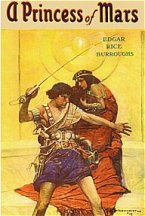
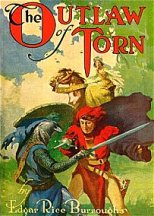
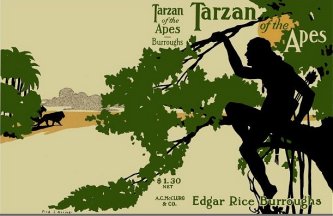
All three novels are replete with Johns, both heroes and villains.ERB's first priority was to reclaim his Anima from John, a male, returning it to a female icon, then exorcising the fixation then rectifying his Animus.
Thus he makes the attempt to merely will his Anima into existence in the person of Dejah Thoris in his first book. You can't will a psychotic reaction away. ERB realizes that he cannot resolve the matter in this way so at that point the air supply on Mars begins to fail and he returns to reality.
Still ERB's Martian alter-ego, John Carter, a carter carries a load so we have John the Load Bearer, has left the the seed or egg of his successor personality behind. Dejah Thoris has laid the egg that will be John Carter's son, Carthoris. Carter-Thoris is a union of Anima and Animus.
Unsuccessful on Mars, ERB goes into a medieval past in Merrie Olde England in his significant story: The Outlaw of Torn. The fixation was created in the past so it will be exorcised in the past. ERB has three psychic problems of which "Outlaw" will resolve or begin the resolution of two.
The problem with ERB's Anima is twofold. John the Bully caused the problem but he was an agent of Fate. ERB perceived that it was Fate that placed him in his situation. ERB's task in "Outlaw" then is to eliminate John while overturning Fate.
"Outlaw" does not succeed particularly well as a novel. No one uninterested in Burroughs would rate it highly, however the psychological content gives the novel a peculiar interest that defies literary considerations.
In the novel, Richard, the son of King Henry III of England, is living a carefree life of privilege as was ERB in Chicago. His father the king insults his fencing instructor, the greatest swordsman in the world, Jules De Vac. Thus Richard/ERB's troubles are caused by parental/ancestral hatreds, i.e. the Anglo-Irish feud.
De Vac swears the cruelest possible vengeance on Henry. He decides to abduct Richard bringing him up to hate his own.
Richard/ERB is playing near his nurse/Anima when he is lured through the gate of his paradise by De Vac. Screaming for help, his cries bring his nurse/Anima to his aid. De Vac brutally murders Richard/ERB's nurse/Anima, thus assuming the role himself.
Fleeing into London, De Vac finds lodgings in the attic of a house built out over the river, water being feminine but flowing under the house. For a not very cogent reason De Vac dons women's clothes which he wears for three years waiting for the heat to die down.
Now, the house is a symbol of the self while the attic is a symbol of the mind. De Vac and Richard/ERB live in the attic as Anima and Animus, from which Richard is forbidden to leave. In other words, ERB's actual Anima is dominated by a man remaining clothed in female garb. We'll see ERB's clever reversal of this situation. Thus ERB was so traumatized that he lived in his mind or imagination for an extended period of time.
At the end of three years De Vac moves Richard/ERB to the dilapidated castle of Torn. In other words ERB has been Torn from his roots, torn from his Anima and divided in his Animus. The dilapidation of the castle signifies the ruin of his personality. Everything's broken down; specifically a long portion of the roof.
For a long time he accepts De Vac's self-defeating instruction without demur. De Vac has made him an outlaw and outcast while at the same time making him the finest swordsman in the world.
Due to De Vac's teaching, Norman, as De Vac has renamed Richard, changing his nationality from English to French, i.e. from English to Irish, becomes a terror to his own people. I don't know how this attitude was reflected in ERB's young life except that he always disappointed his family and friends.
As Norman/ERB becomes more familiar with the world he begins to see the falsity of De Vac's teaching. He develops a malaise.
The turning point comes when he is escorting the maiden, Joan de Tany, pronounced Tawney, to London. On the way De Vac, as Fate, warns the authorities that Norman of Torn is on the way. Even though Norman acquits himself well at the Crossroads, where he is intercepted, he is knocked unconscious by superior numbers, twenty to one. While he is acquitting himself well in front he is knocked unconscious from behind. Perhaps a rationalization. Among his attackers is John de Fulm, the Earl of Buckingham. John takes Joan/Anima and Norman/ERB to his castle. With the aid of Joan and his prowess as a swordsman Norman and Joan escape the castle but she and he still separate because Norman/ERB is in love with Bertrade de Monfort. Apparently he has no use for his violated Anima. Joan then commits suicide, as his original Anima had been killed by John the Bully.
Returning to the castle with a number of men Norman/ERB enters the castle by the subconscious route of the concealed postern gate with the intent to dispatch John de Fulm, Earl of Buckingham. Buckingham is later recalled in another incarnation in Tarzan and the Lion Man where his is disposed of for good.
John de Fulm is not in the castle, having left for a dalliance with another man's wife. Norman pursues him to this castle, entering once again through a postern gate in the back of the castle. He shows up in the dining hall as de Fulm and his hostess are seated at dinner to demand satisfaction of John. ERB tells the story thusly, Norman is speaking:
"In a grim old castle in Essex, only last night, a great Lord of England held by force the beautiful daughter of a noble house, and, when she spurned his advances, he struck her with his clenched fist upon her fair face, and with his brute hands choked her. And in that castle also was a despised and hunted outlaw, with a price upon his head, for whose neck the hempen noose had been yawning these many years. And it was this vile person who came in time to save the young woman from the noble flower of knighthood that would have ruined her young life.
"The outlaw wished to kill the knight, but many men-at-arms came to the noble's rescue, and so the outlaw was forced to fly with the girl lest he be overcome by numbers, and the girl thus fall again into the hands of her tormentor.
"But this crude outlaw was not satisfied by merely rescuing the girl, he must needs mete out justice to her noble abductor and collect in full the toll of blood which alone can atone for the insult and violence done her.
"My lady, the young girl was Joan de Tany, the noble was My Lord the Earl of Buckingham, and the outlaw stands before you to fulfill the duty he has sworn to do. En Garde, My Lord!"
The encounter was short, for Norman of Torn had come to kill, and he had been looking through a haze of blood for hours -- in fact, every time he had thought of those brutal fingers upon the fair throat of Joan de Tany and of the cruel blow that had fallen on her face.
He showed no mercy, but backed the Earl relentlessly into a corner of the room , and when he had him there where he could escape in no direction, he drove his blade so deep through his putrid heart that the point buried itself an inch in the oak panel.
The inferiority complex created by John the Bully is evidenced in Norman's being a "vile outlaw" destined for the "hempen noose." He nevertheless was more noble than the Noble John de Fulm. Joan may be interpreted as a variant of John. The scene at the Crossroads and in the first castle is a poetic representation of what occurred on the street corner in Chicago. John de Fulm is placed in a situation where he could escape in no direction -- the same as John the Bully had done to ERB. Burroughs' extreme hatred of John the Bully is evidenced by the point of his sword penetrating "through (de Fulm's) putrid heart" an inch into the oak panel. Oak is a very hard wood. Apparently Norman/ERB with his precise control of his weapon misjudged the distance through his haze of blood.
Thus ERB exorcises his central fixation creating the means to integrate his personality, freeing him from his debilitating fixation. The Thief is dead.
At novel's end Norman kills De Vac in a very hard fought duel in which he himself is nearly killed. Did ERB think he had killed Fate? The result appears to be that his Anima is no longer male clothed in female garb but female clothed in male garb. ERB is now ready to resolve the problem of his Anima, but not right away.
Having failed to will his Anima into existence in A Princess Of Mars, Burroughs had wrestled with the problem in Outlaw Of Torn while to some extent freeing his Animus from dependence on John the Bully. He had resolved his central childhood fixation so that he could begin to reclaim his own identity.
Thus in his third book Tarzan Of The Apes he creates a true alter ego for himself. John Carter as ERB's prefaces show was never a part of his ego, always being outside himself and separate. Tarzan was an extension of his ego.
John the Bully had given Burroughs a sense of inadequacy. He felt himself physically inferior. In the image employed by a famous body builder he had had sand kicked in his face and could do nothing about it. At first blush Tarzan looks like an impossible figure for Burroughs to aspire to. However if one harks back to the Columbian Expo of 1893 one will remember that Burroughs became fascinated with the strongman, Sandow.
Sandow promised that any man could become well developed. Taking the hint an American by the name of Bernarr Macfadden, who also saw Sandow at the Fair, became the father of American bodybuilding. He began a magazine entitled Physical Culture. He was the first or among the first magazine editors to use photography rather than drawings. Burroughs, then, would have had actual photographs of bodybuilders to examine. They proliferated after the fair.
It would seem inevitable that one as interested in magazines as Burroughs was would have been familiar with the magazine, especially with his interest in strongmen. Macfadden moved his headquarters to Chicago in 1908 so that Burroughs would have ample opportunity to visit Physical Culture's offices while perhaps picking up a pamphlet or two.
As Macfadden promised that physical fitness and the right diet, the fad for carrot juice came from Macfadden, could cure all ills. Burroughs, still suffering from the effects of Toronto would have been drawn to Macfadden's ideas to seek relief. Ogden Secor in 1913's Girl From Farris's took up a fitness program which helped him a great deal.
Thus when he began to project his alter ego in defence of John the Bully's introjection on his ego he naturally chose the image of the strongman for his ideal. As much as he admired the bodybuilders he didn't like their bulky appearance. In his need to be brave he also was a boxing fan. Gentleman Jim Corbett was probably his ideal, especially as 'the little guy from Caliifornia' was able to defeat that incredible hulk, John L. Sullivan.
Corbett had a sleeker build while having the heart of a lion so that ERB combined the two to form Tarzan, A giant of incredible strength but with 'smooth, rippling muscles.'
Tarzan thus becomes a psychological projection rectifying ERB's emotional inadequacies. This can be added to the literary sources which while though important are secondary.
Having now begun to resolve his psychological dilemma he pursued it assiduously over the next few years.
Let me now add some comments about The Lad And The Lion and give some analytical comments about ERB's Mucker Trilogy: The Mucker, Out There Somewhere and Bridge And The Oskaloosa Kid otherwise known as Mucker, Return Of The Mucker and The Oakdale Affair.
A severe psychological fixation is such that you can't stop talking about it even thought the discussion is thoroughly disguised. Take ERB's Doodad or colophon used on ERB, Inc.'s books. You have two parallel lines representing the Anima and Animus. The lines are broken near the top representing ERB's psychotic reaction at age eight. A strong bar seals off the bottom of the top or the past from the future, there is a gap and then a strong bar seals off the top of the bottom which corresponds to the rest of ERB's life. The gap probably represents the three years between nine and twelve in ERB's life. Fixated by John the Bully, who was twelve, it may be that ERB was only able to resume his life when he attained the age that John had been. You will notice that ERB equivocates about his own age, eight or nine, but he positively states that John was twelve.
In The Lad And The Lion the Lad drifts in a disabled ship for about ten years. The ship is another representation of self, here injured beyond repair, unable to function, drifting helplessly. It drifts across the sea which is female, or the water beneath the house in "Outlaw." The Lad is abused during this period by an insane epileptic, an incarnation of John the Bully and another example of De Vac. A lion cub which grows to maturity is tormented in a cage corresponding to the male dominated Anima of Burroughs. The lion is also a predecessor of the Golden Lion who was the antagonist of Nemone's lion in the "City of Gold."
The wrecked ship finally lands on the desert rather than watered jungle coast of Africa. ERB is leading a barren life without water or, in other words, feminine comfort. His psychological state must have been very uncomfortable. Here the Lad is reunited after difficulties with his Anima or, water in the desert.
Both "Lad" and the desert scenes of The Return of Tarzan appear to be influenced by a 1904 literary Anima novel of Robert Hichens placed in the Sahara titled The Garden of Allah. "Garden" is not a bad story told in an eerie out-of-body style with details as outre, need I say bizarre, as any of Burroughs' novels. Before ERB wrote "Lad" in February and March of 1914 he completed the first of the Mucker trilogy from August to October of 1913.
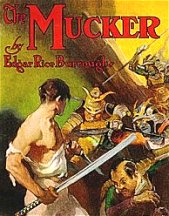
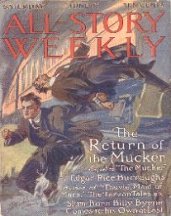
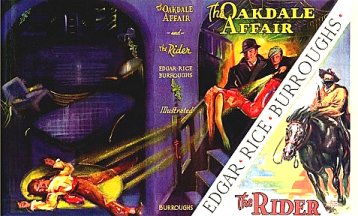
The Mucker introduces John the Bully as Billy Byrne, an Irish mucker or hoodlum of the Chicago streets. Burroughs is unable to hate John the Bully as Byrne is depicted as the result of his environment while he at least partially redeems himself by novel's end.Of importance is Byrne's relationship to ERB's alter-Anima heroine, Barbara Harding. In the jungle, read on the street corner, a sort of bond develops between the refined Anglo Miss Harding and the crude, degraded Irish thug, Billy Byrne. Upon the return to civilization their differences in breeding become a barrier. Miss Harding is embarrassed by Byrne, while on his part he realizes that an Irish mucker has no place in Miss Harding's refined Anglo world. So Byrne/John the Bully renounces a claim on Burroughs' Anima. This is only a partial resolution as ERB has not yet claimed his Anima in her own sex.
ERB apparently had to work hard to resolve this dilemma because the second volume of the trilogy was not written until January-March 1916. The Return of the Mucker introduces an alter-Animus figure of ERB named Bridge. This is a significant name, for the Anglo Bridge bridges the transition from the Irish Byrne to the assumption of ERB's own personality as Anglo Burroughs.
Now the Joker turns the tables on the Thief to claim his own as well as find his way out of there.
Byrne is a genuine bum while Bridge is a "volunteer" who "prefers" life on the Open Road. This is another version of Norman the Outlaw. Bridge is a Virginian, hence an ultimate hero figure in Burroughs' iconography, and a worthy Animus figure for ERB. Remember ERB became an "auto-gypsy" taking to the open road in 1916 as this novel was being written.
The resolution of the Anima-Animus problem is completed in The Oakdale Affair of January-June 1917. Apparently the last of the trilogy caused ERB real problems; it took twice as long to write as the other two. In this novel ERB succeeds in making his Anima all female while clothing his Animus figure in the acceptable but still split male figure of Bridge.
His Anima figure is Abigail or Gail Prim. She is the daughter of a Banker, the American equivalent of a Prince, making her a Princess. She disguises herself as a boy then steals her own cash and jewels. This stash represents the female treasure a man acquires in a woman. Significantly, she stores it in a man's jacket pocket.
She then actually falls in with a band of thieves who are going to both kill and rob her. Hark back to John and ERB on the street corner on the way to Brown. As a slightly comic figure she escapes and while fleeing down the highway pursued by the thieves she runs into the Happy Hobo, Bridge. Where? Not at the Crossroads as in "Outlaw" but at a fork in the road. Read street corner.
Bridge/ERB is strangely attracted to what he believes to be a boy. He can't understand it but he wants to protect this boy. Bridge is able to preserve the boy/girl from the criminals during a long series of adventures. Characteristically they are both on the verge of death by the "hempen noose" when succor comes. As it turns out the boy is a girl and Bridge is not a bum but an English, Virginian gentleman of means.
Whereas De Vac of "Outlaw" had been a man in women's clothes, Gail was a girl in men's clothes. After working out a few trifles her "true personality" is revealed as she dons beautiful women's raiment so that ERB's Anima is now a woman in woman's clothes. Bridge removes the Irish influence of John the Bully allowing ERB to assume his true personality as a whole, or nearly whole English man. He still has a divided Animus.
It is interesting that late in his career he assumed the pseudonym of John Tyler McCulloch, thus using John with an Irish surname and a middle name taken from his father. You will remember that Tarzan slew all those lions using his father's blade. For all we know McCulloch may have been John the Bully's real name.
Although his Anima and Animus have been returned to their proper relationship ERB still has an Animus conflicted by the dual identities of hero and coward, a residue left by the Thief on his departure. Part of the Joker identity remains.
That problem will be resolved over the course of the Tarzan oeuvre from "Jewels of Opar" to "Lion Man."
To return to Tarzan of the Apes ERB had actually talked his way through the integration of his personality in "Outlaw." Now devoid of any identity since he had eliminated the John the Bully/ERB dichotomy, ERB has to assume a new identity; he has to be born again.
ERB was groping his way along; he wasn't really aware of what he was doing although he knew his goal. He had an idea of what he wanted to be. Thus he created the character of the able, confident king of the jungle, Tarzan. He would eventually attempt to assume the identity of Tarzan after Tarzan and the Lion Man with semi-disastrous consequences.
In his quest for wholeness or integration it appears that by 1913 he had managed to talk his way out of his fixation and by 1917 reassumed the control of his Anima. He had given birth to his successor personality in the form of Tarzan, so that the true origin of Tarzan his true antecedents, lay in his confrontation with John the Bully on a street corner in 1983 or 84. How he organized the character of Tarzan from literary sources is a separate but related story.
Thus with A Princess of Mars, Outlaw of Torn and Tarzan of the Apes Burroughs laid the groundwork for his psychological recovery. The next fifteen or so novels would deal with various aspects of recovery. I believe that much of Tarzan's appeal lies in this psychological background projected onto ERB's novels which in itself forms part of every man's background. Some deal with the problem successfully fighting the bully and winning or at least showing courage. Some disregard the bully and some go out of their way to avoid the bully. some just get clobbered. The effect such a confrontation has on one's psychology and character depends on how one deals with it. For ERB the result was disastrous. The remarkable thing is that he, the Joker, ultimately defeated his Antagonist the Thief. Still, all his life that Empty Handed Painter was drawing crazy patterns on his sheets.
I thought I was alone
but the past was just behind.Bob Dylan ~ Tangled Up In Blue
|
and Follow the Navigation Chart for the Entire Series of Articles |
|
Differing viewpoints are welcome. |
|
are not necessarily those held by Edgar Rice Burroughs, Inc. |
![]()
![]()
![]()
![]()

![]()
BILL
HILLMAN
Visit
our thousands of other sites at:
BILL
& SUE-ON HILLMAN ECLECTIC STUDIO
ERB
Text, ERB Images and Tarzan® are ©Edgar Rice Burroughs, Inc.-
All Rights Reserved.
All
Original Work ©1996-2004/2010 by Bill Hillman and/or Contributing
Authors/Owners
No
part of this web site may be reproduced without permission from the respective
owners.